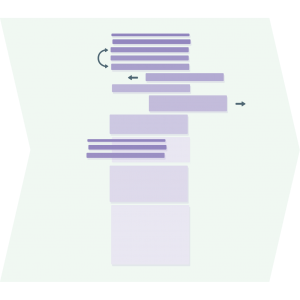The Team Backlog Refinement is the process of adding details to the Team Backlog entries, making estimates, and determining the order of the Team Backlog entries. Refinement is a continuous process in which the Team Product Owner and the Working Team together detail the Team Backlog entries. When the Team Backlog is refined, the entries are examined and revised. It should normally not take up more than 10% of the Working Team’s capacity. However, the Team Product Owner can update or have the entries in the Team Backlog updated at any time.
The Team Backlog Refinement mainly serves to prepare the next Team Planning. The Team Product Owner presents new team backlog items to the Working Team, and has them estimated by the Working Team. If items are about to start, the team makes sure that the entries are small enough that they can be pulled into an iteration. (This is a prerequisite for the “pull” and is often also referred to as part of the Definition of Ready (DoR)). If this is not the case, the team refines the corresponding entry by splitting it into several entries.
If the team does not work in iterations, but continuously using Kanban, the team agrees on an estimate limit from which it is necessary to split Backlog Items.
Estimation of the implementation effort of backlog entries
Estimates by the entire team are important for two reasons
- By estimating together, the entire team analyzes the respective backlog entry from different perspectives and enriches it with information such as acceptance criteria and boundary conditions. The first ideas for implementation are also generated.
- The result of the estimate is a number with which individual backlog elements can be evaluated, for example for prioritization. In addition, it is now easy to calculate how many elements can be dragged into an iteration, namely by comparing the backlog elements completed in the last iterations (team velocity ).
The team uses the Planning-Poker ® method to estimate the effort .
–
Further suitable links:
| Events | Roles | Groups | Artifacts |
| Team Planning
. . |
Team Product Owner | Working Team | Team Backlog |
